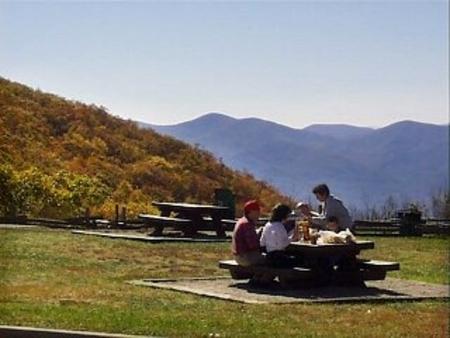The Jan/Feb 2009 issue of the AARP Magazine has an interesting little article entitled “America the Economical.” It offers seven tips for seniors who want to save money on their trips to national parks.
Noting that seniors will find national park trips distracting (excessive worry is bad for you) and healthy (clean air and scenic vistas are invigorating), AARP offers these tips:
• Stay in the park; in-park rooms are often cheaper.
• Book yourself; don’t pay fees for reservations you can make yourself.
• Pitch a tent; campsites are cheaper than rooms.
• Share a shower; rooms lacking private bathrooms cost less.
• Exercise your mind; many parks offer lectures and guided hikes at no cost.
• Skip the summer; off-season rates are cheaper.
• Take a pass; for just $10 you get a lifetime Senior Pass for free admission.
All seven tips are just fine, but Traveler would like to suggest an additional one.
• Plan a picnic; restaurant meals can be budget-wreckers.
Concessionaires offer fast food and/or cafeteria style service in most popular parks (Great Smoky Mountains National Park being a notable exception), and many destination parks also have full service restaurants. These are just fine. Many park visitors find food services very convenient, and in some cases -- the $$$$ Bracebridge Dinner at the Ahwahanee Hotel in Yosemite National Park being the most outstanding example – the dining experience is itself a treasured memory.
But if you are truly looking for ways to cut your costs, why pay concessionaire prices for food service in the national parks? Nearly all of the nature-based parks and many of the cultural/historical ones have picnic tables or other facilities you can use for dining “al fresco, el cheap-o.” You can save money by bringing your own food and drink or buying the fixings in the park stores. In fact, if you visit enough national parks and spend enough time in them, this strategy can save you a lot of money.
Lots of seniors I know compromise by fixing their own breakfast and lunch, then taking their evening meal in a fast foodery, cafeteria, or full service restaurant.
Postscript: Be aware that bringing food with you can be very problematic in bear country. Picnickers may be accosted by bears looking for food. In Yosemite and several other national parks, black bears have become highly skilled at ripping vehicles open to get at food stored inside. I’d personally be very reluctant to practice the bring-your-own-food strategy in a park that has problem bears.


 Support Essential Coverage of Essential Places
Support Essential Coverage of Essential Places







Comments
Blessed are the senior retirees!
So many times within and around many of Our National Parks have they given this scruffy backpacking scrambler a ride,
a beer, fed me, shared the warmth of their fire, let me use the shower in their room etc.
Thank You!
The cafeteria at Yosemite Lodge has a great Trout dinner with veggies for about $7. HOW CAN YOU BEAT THAT!
Darn it, Ken. Now you've gone and ruined my dinner. All I can think about is that trout! :(
Some of these "tips" are unhelpful in light of many parks' intense seasonality.
Re. Stay in the park; in-park rooms are often cheaper: "Often" does not mean "always." Not having to drive in and out of a park DOES save gas and wear-and-tear on the vehicle. AARP didn't mention that.
Pitch a tent; campsites are cheaper than rooms: Oh come now. What were they thinking? I'll wager that most AARP members are beyond being willing to pitch a tent and trek to the toilets in the middle of the night. How about suggesting renting a self-contained RV, which provides at least minimal creature comforts, including a bathroom, electric lights, a real kitchen and heating/cooling. No hotel room at all. No dealing with rain, wind, heat or cold. No sleeping in a sleeping bag on a Thermarest or low cot. The ability to prepare 3 meals a day.
Re. Skip the summer; off-season rates are cheaper: In some case/places, there are no off-season rates at all because properties are closed. Examples? Far View Lodge at Mesa Verde Natl Park; Crater Lake Lodge in Crater Lake NP; and lodges in Glacier NP are among those closed in winter, while the Furnace Creek Inn in Death Valley NP is closed in summer. Of course, if these tips include loding near the park, off-season rates ARE generally lower. Also, in snow country, while the parks are technically open, many roads are unplowed, and snowshoes or cross-country skis (or very occasional snowmobiles) are required to get into the park at all.
Thanks, Claire. I didn't address the seasonality issue because I assumed that seniors would be using these tips for travel throughout 2009. I think that's what the author had in mind.